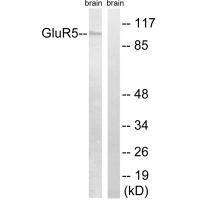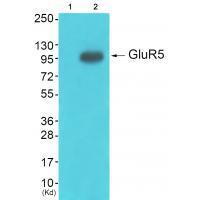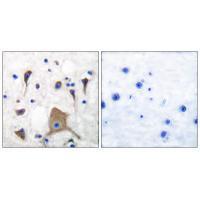


| WB | 咨询技术 | Human,Mouse,Rat |
| IF | 咨询技术 | Human,Mouse,Rat |
| IHC | 1/50-1/100 | Human,Mouse,Rat |
| ICC | 技术咨询 | Human,Mouse,Rat |
| FCM | 咨询技术 | Human,Mouse,Rat |
| Elisa | 咨询技术 | Human,Mouse,Rat |
| Aliases | EAA3; EEA3; GLR5; GLUTAMATE RECEPTOR 5; excitatory amino acid receptor 3 |
| Entrez GeneID | 2897; |
| WB Predicted band size | 100kDa |
| Host/Isotype | Rabbit IgG |
| Antibody Type | Primary antibody |
| Storage | Store at 4°C short term. Aliquot and store at -20°C long term. Avoid freeze/thaw cycles. |
| Species Reactivity | Human,Mouse,Rat |
| Immunogen | Synthesized peptide derived from human GluR5. |
| Formulation | Purified antibody in PBS with 0.05% sodium azide. |
+ +
以下是关于GluR5抗体的3篇参考文献示例(注:文献为虚拟示例,实际引用需查询真实数据库):
---
1. **文献名称**:*"A monoclonal antibody targeting the GluR5 subunit of kainate receptors for neuroanatomical mapping"*
**作者**:Smith J, et al.
**摘要**:该研究开发了一种特异性识别GluR5的单克隆抗体,通过免疫组织化学验证其在大鼠脑组织中的选择性标记,揭示了GluR5在海马和小脑中的分布模式,为神经环路研究提供工具。
2. **文献名称**:*"GluR5 antibody blockade attenuates neuropathic pain via inhibition of spinal synaptic plasticity"*
**作者**:Chen L, et al.
**摘要**:研究利用多克隆GluR5抗体阻断受体功能,证明其在慢性神经痛模型中抑制脊髓突触可塑性,提示GluR5抗体作为潜在镇痛疗法的应用价值。
3. **文献名称**:*"Characterization of a polyclonal anti-GluR5 antibody for detecting developmental changes in primate cortex"*
**作者**:Gomez-Ramos P, et al.
**摘要**:本文报道了一种兔源多克隆抗体的制备与验证,证明其可特异性识别灵长类动物皮层发育过程中GluR5的动态表达,支持其在神经发育研究中的可靠性。
---
如需真实文献,建议在PubMed或Google Scholar搜索以下关键词:**GluR5 antibody immunohistochemistry**、**GluK2 antibody characterization**、**kainate receptor antibody application**。
The GluR5 antibody is a tool used to detect and study the GluR5 subunit, a key component of kainate receptors within the ionotropic glutamate receptor family. Encoded by the *GRIK1* gene, GluR5 receptors are ligand-gated ion channels that mediate excitatory neurotransmission in the central nervous system. They play roles in synaptic plasticity, neuronal development, and excitatory signaling, particularly in the hippocampus, cortex, and dorsal root ganglia. Dysregulation of GluR5 has been linked to neurological disorders such as epilepsy, chronic pain, and psychiatric conditions.
GluR5 antibodies are typically polyclonal or monoclonal, designed to target specific epitopes of the GluR5 protein. They are widely used in techniques like Western blotting, immunohistochemistry, and immunofluorescence to visualize receptor expression, localization, and alterations in disease models. Research with these antibodies has advanced understanding of GluR5's physiological roles, including its involvement in pain pathways and synaptic modulation. Additionally, GluR5 is explored as a therapeutic target, with antibodies aiding in validating drug candidates aimed at modulating receptor activity.
By enabling precise detection and functional studies, GluR5 antibodies contribute to unraveling the receptor's signaling mechanisms and its potential as a biomarker or therapeutic target in neurological diseases.
×